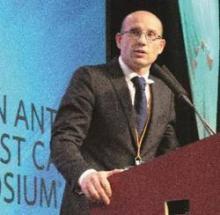SAN ANTONIO – An accelerated course of partial breast irradiation was as effective as whole breast irradiation for women with early breast cancer, with significantly fewer adverse events.
The technique may be a suitable alternative for select patients who wish to minimize side effects without compromising clinical outcomes, Dr. Lorenzo Livi said at the San Antonio Breast Cancer Symposium.
He reported the 5-year results of an Italian study that randomized women with early breast cancer to one of two radiation regimens: conventional (tangential field) fractionated whole breast treatment or accelerated partial breast irradiation plus intensity-modulated radiotherapy.
The patients were highly selected, with a primary tumor size of less than 25 mm and negative surgical margins of more than 5 mm, said Dr. Livi, a radiation oncologist at the University of Florence, Italy.
The cohort comprised 520 women. Most (about 85%) were node-negative; 95% of the tumors were estrogen receptor–positive, and 90% were progesterone receptor–positive. The most frequent molecular subtype was luminal A (about 75%); less than 5% were triple-negative.
The median follow-up for this portion of the study was 5 years. There were six ipsilateral breast tumor recurrences – three in each group. There were three local relapses, all in the whole breast irradiation group. The 5-year recurrence rate was 1.4% in the whole breast irradiation group and 1.5% in the partial breast irradiation group. The mean time to ipsilateral breast recurrence was 3 years, and there was no significant between-group difference in this timing.
There were 10 contralateral recurrences (seven in the whole breast group vs. three in the partial irradiation group). Distant metastases occurred in seven patients (four and three, respectively).
The 5-year overall survival rate was excellent, Dr. Livi noted: 97% in the whole breast irradiation group and 99% in the partial irradiation group.
Skin toxicity of any grade was significantly less common in the partial group (49 vs. 181). Significantly more patients in the partial irradiation group were completely free of adverse events (197 vs. 93). There were no grade 3 adverse events in either group. Two women in the whole breast irradiation group experienced a grade 2 toxicity- both of these were skin fibrosis.
Almost all patients (90%) reported good or excellent cosmetic results.
Dr. Livi fielded a few questions during the discussion period, one of which dealt with the cost of partial irradiation treatment. Since the procedure is more expensive, and the results similar, the discussant wondered whether it would be worth the additional cost. Dr Livi said the question is difficult for him to answer, because Italy’s national health care system does not charge patients for the treatment. He did say reimbursement for the treatments differs, but he did not elaborate.
He had no financial disclosures.
On Twitter @alz_gal


